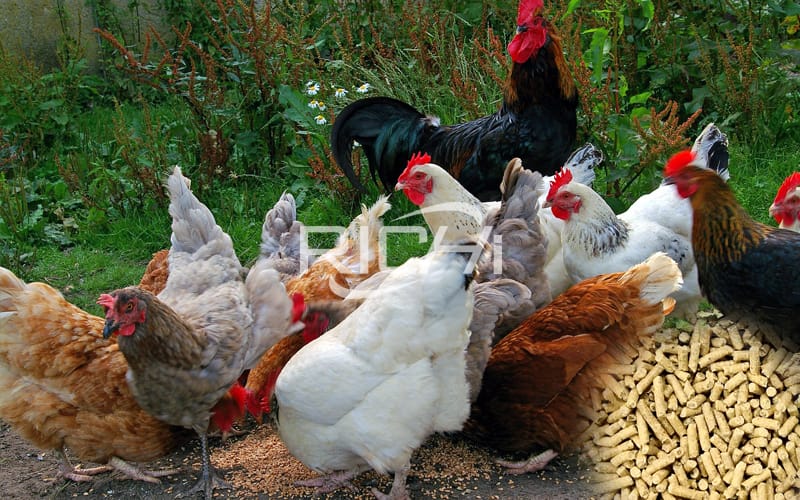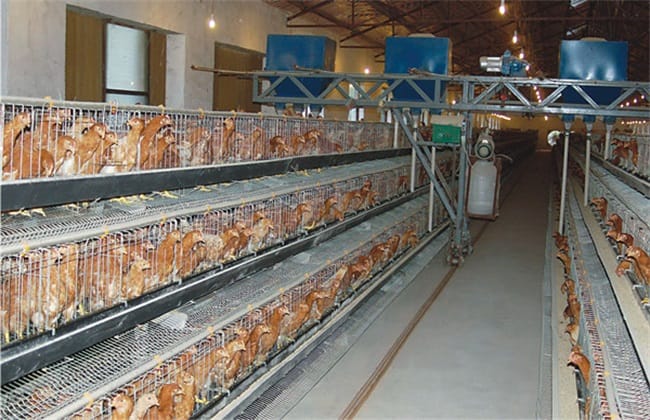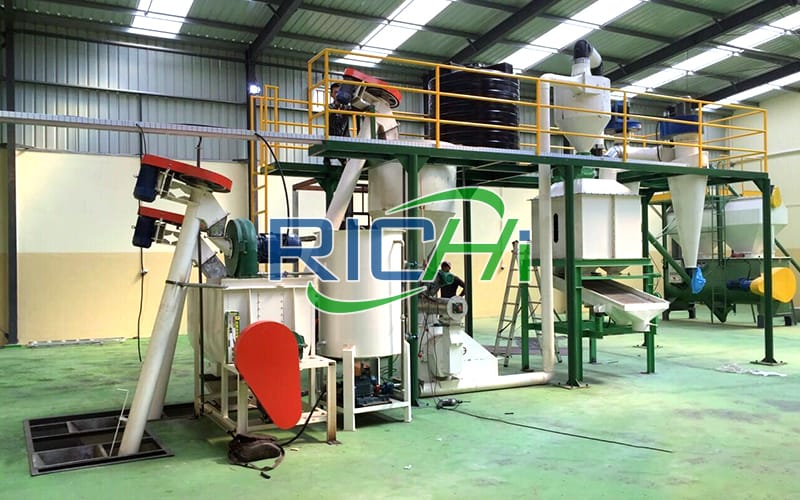1. What are the needs of growing chickens for chicken feed?
In order to give full play to the genetic performance of contemporary excellent laying hen breeds (lines) with large numbers of eggs, large eggs, and high feed conversion rate, breeding an ideal reserve chicken is the key. The ideal reserve chicken must be tidy when bred, the weight meets the requirements, the muscles and bones are well developed, but there should be no excessive body fat.

Only reaching sexual maturity under the appropriate weight and body size for the growing chicken age, can we obtain a higher egg production peak, prolong the peak duration, obtain the ideal egg weight, and improve the survival of the laying hens. Therefore, it is necessary to adopt a suitable breeding system and lighting system. These systems are closely integrated with growth rate control and disease control management systems, and the ideal breeding effect will be achieved.
Crude protein level requirements
The gonads of the laying hens in the rearing period have begun to move. If the crude protein level in the feed is too high, the growth of the gonads of the chickens can be accelerated, making the laying hens sexually mature, but the bones and muscles of the chickens cannot be fully developed, resulting in thin bones of the laying hens. The size is small, and the laying age is earlier, but the egg weight is small and the egg production is lower. At 7-12 weeks of age, the crude protein content in the feed is 15-17%. At 14-17 weeks of age, because the skeletal system is almost fully developed, the protein ratio can be reduced by 1% per week until the crude protein level is 13-14%.
Metabolizable energy level requirements
Metabolic energy is easy to deposit fat in the body of chickens in the rearing period, which affects the later performance of egg production and the fertilization rate of breeding eggs. Therefore, it is also necessary to control the level of metabolic energy in the feed.
Material mineral requirements
In order to improve the calcium storage capacity of the hens, the growing hens should be fed diets with lower calcium content. Only after laying eggs, they should be fed with high-calcium feeds so that there are a large amount of calcium in the hens. To make full use of the high-yielding characteristics of excellent laying hens. But also pay attention to the proper ratio of calcium, phosphorus, manganese, zinc and other minerals in the feed, because this is an essential nutrient element to ensure the normal growth and development of chickens. The ratio of calcium to phosphorus for developing chicks should be 1:1.5 or 2:2.1.
Multivitamin needs
In order to promote the development of digestive organs such as the stomach and intestines of grown-up chickens, and enhance their digestive functions, and to ensure the health of the chickens, the amount of bran feed and green feed should be gradually increased in the grown-up feed to increase the amount of multiple vitamins. The feed intake of large chicks generally requires that the crude fiber content in the feed can reach 5%, the maximum dosage of bran feed can reach 15-12%, the green feed can reach 20-30%, and the dosage range of multivitamins is 0.01 -0.04%.

2. Precautions for limiting feeding of laying hens during growing period
The stage after the laying hens reach 20 weeks of age is called the rearing chicken, also called the reserve chicken. According to the growth and development characteristics of growing chickens, in order to maintain the normal growth and development of growing chickens, sufficient energy, protein, macro minerals, trace elements, vitamins and amino acids and other nutrients are required. To meet the needs of the corresponding nutrients for growth and weight gain, the chicken body cannot develop healthily, and the chicken flock will not obtain a more uniform order, and the laying hens in the laying period will not be able to give full play to their good qualities. The laying performance of eggs. Therefore, in actual work, it is necessary to not only meet the full price needs of feed dosage and ingredients for growing chickens, but also pay attention to strengthening management, strictly restricting feed, and controlling its appropriate age at the beginning of production, which is very necessary to improve the production performance after delivery. .
The so-called feeding restriction refers to a feeding method that limits the level or quantity of rations in order to obtain the standard body size and weight of adult laying hens, so that they can start production in time at the age of laying hens. , Often called restricted feeding, that is, restricted feeding.
(1) Feed restriction method
- Limit the amount of feed (also called the limit method).
- Limit the nutrient levels such as energy, crude protein or methionine and lysine in the diet (also called the limit method).
(2) The purpose of feeding restriction
In the rearing stage, the bones, muscles, feathers and reproductive organs of the chickens grow and develop rapidly, the feeding ability is very strong, and they eat more food. The chickens have poor control over the feeding, and it is easy to overweight the growing chickens. In order to prevent premature sexual maturity of laying hens and excessive body weight of adult hens, which will affect the full performance of laying performance, in the breeding process, feeding restriction technology is often used to achieve timely production of laying hens and obtain standard body weight. The purpose of ruler and weight.
At the same time, in the process of feeding restriction, some weak and unhealthy chickens can be eliminated in advance, thereby reducing the rate of dead scouring of laying hens during the laying period, saving feed, and controlling the growth and development speed can prevent Excessive fat deposits in hens reduce the number of chicks after laying, which improves the level of production and economic benefits.
(3) Matters needing attention
- Starting from reality, formulate a feeding restriction plan according to the growth age, growth and development standards and conditions of the growing chickens.
- Make preparations before feeding restriction, sufficient number of troughs, etc., and the feeding speed must be fast so that all eat food at the same time in the slot.
- Pay attention to the weight and body size measurement, frequently observe the health status of the chickens, and deal with the problems in time.
- Light white-shell laying hens generally do not advocate feeding restrictions; medium-heavier brown-shell laying hens are encouraged to restrict feeding during the rearing period.

3. How to process feed for growing chickens?
- If you have a small chicken farm, you only need to make a simple self-prepared chicken feed. Only need corn pulverizer for chicken , chicken feed mixer equipment and chicken poultry feed pellet making machine to complete the processing of chicken feed.
- If you have a large chicken farm, or you want to sell your processed chicken feed and start a chicken feed processing business, then you should build a chicken feed production line. Chicken feed pellet processing line is generally consisted of chicken feed grinding machine, chicken feed mixer, chicken feed pellet mill machine, cooler, packing scales, etc.
Tell us your raw material, requirements of capacity and budget for the chicken poultry feed mill. Then Richi Machinery can design a suitable and specific solution for you. To ensure the success of your business, we will provide detailed solutions including material storage, pretreatment, crushing … pelleting, cooling, packaging and waste disposal(E.g. chicken manure organic fertilizer production line).
3.1 Expanded: Chicken feed production equipment guide
Core equipment & functions
- Grinding (hammer mill / crusher): Particle size control for digestibility; match screen size to bird age. See chicken feed grinding machine.
- Mixing (ribbon / paddle / twin-shaft): Achieve CV ≤7% uniformity; options with liquid addition & trace dosing. See feed mixer.
- Pelleting (ring die pellet mill): Improve feed conversion, reduce wastage; conditioner for steam cooking. See chicken feed pellet mill machine.
- Cooling & Crumbling: Counter-flow cooler for moisture/temperature pull-down; crumbler to make starter crumbles.
- Screening & Packing: Rotary/vibratory screens for fines removal; electronic packers for 25–50 kg.
Configuration by capacity
- <1 tph (small farm): Compact line (crusher + mixer + small pellet mill), manual bagging.
- 1–5 tph (small/medium): Separate grinder & mixer, ring-die pellet mill (SZLH250–320), bucket elevator, simple cooler.
- 5–10 tph (commercial start): Twin-shaft mixer, conditioner + steam system, counter-flow cooler, crumbler, rotary screener, auto-packing.
- >10 tph (industrial): Multi-bin batching, premix micro-dosing, dual-line pelleting (SZLH350/420+), PLC+SCADA.
Selection tips
- Match die size to bird age: starter 2.0–2.5 mm, grower 3.0–3.5 mm, finisher 3.5–4.0 mm.
- Conditioning is key: Aim 80–85 °C, 15–30 s; improves PDI and pathogen reduction.
- Uniform mixing: Choose mixer volume so typical batch reaches 60–80% fill for best CV.
- Dust & safety: Cyclone/bag filters, explosion vents on silos, magnets & sifters on intake.
- Steam & utilities: Stable steam (0.2–0.4 MPa) for pelleting; size compressor for actuators & packers.
Optional modules
- Liquid addition (oil, molasses, enzymes), vacuum coating for heat-sensitive additives.
- Automated batching with load cells and micro-ingredient stations.
- HACCP sanitation design: clean-in-place (CIP) for liquid lines, segregated premix area.
Why choose RICHI Machinery
- Turnkey design from raw material intake to packing and dust control.
- Process guarantees on throughput, CV, and pellet durability with local commissioning.
- Spare parts & after-sales network; die/roller optimization for local recipes.
4. Feed formula for growing chickens
The digestive function of the bred chicken is gradually improved, the feed intake is increasing day by day, and the skeletal muscles are in a period of vigorous development. The nutritional level at this time should be quite different from that of the chicks, especially the protein level should be gradually reduced, and the energy should also be reduced, otherwise, a large amount of fat will accumulate, causing overweight and affecting the egg production after adulthood. Diet formula:
(1) 7 to 14 weeks of age. Cornmeal 54.13%, sorghum 7.0%, wheat bran 10.0%, barley 5.0%, fish meal 5.0%, soybean cake 10.0%, leaf meal 6.0%, bone meal 2.5%, table salt 0.37%. The content of crude protein in the diet should reach 15%, metabolizable energy 11.49 MJ/kg, calcium 1.70%, and phosphorus 0.6%;
(2) 15-20 weeks old. Corn flour 47.13%, sorghum flour 10.0%, wheat bran 15.0%, barley 12.0%, fish meal 2.0%, soybean cake 4.0%, leaf meal 7.0%, bone meal 2.5%, and salt 0.37%. The content of crude protein in the diet should reach 13%, metabolizable energy 11.28 MJ/kg, calcium 0.9%, and phosphorus 0.5%. In addition, a variety of vitamins and trace elements are appropriately added during the feeding process to meet the physiological needs of growing chickens.
Grower diet summary
| Age | Key Ingredients (%, as-fed) | Crude Protein | ME | Calcium | Phosphorus |
|---|---|---|---|---|---|
| 7–14 weeks | Cornmeal 54.13, Sorghum 7.0, Wheat bran 10.0, Barley 5.0, Fish meal 5.0, Soybean cake 10.0, Leaf meal 6.0, Bone meal 2.5, Salt 0.37 | 15% | 11.49 MJ/kg | 1.70% | 0.60% |
| 15–20 weeks | Corn flour 47.13, Sorghum flour 10.0, Wheat bran 15.0, Barley 12.0, Fish meal 2.0, Soybean cake 4.0, Leaf meal 7.0, Bone meal 2.5, Salt 0.37 | 13% | 11.28 MJ/kg | 0.90% | 0.50% |


